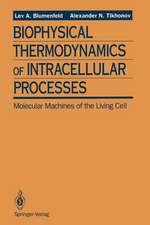Dynamics and Mechanism of DNA-Bending Proteins in Binding Site Recognition: Springer Theses
Autor Yogambigai Velmuruguen Limba Engleză Hardback – 16 dec 2016
Many cellular processes involve special proteins that bind to specific DNA sites with high affinity. How these proteins recognize their sites while rapidly searching amidst ~3 billion nonspecific sites in genomic DNA remains an outstanding puzzle. Structural studies show that proteins severely deform DNA at specific sites and indicate that DNA deformability is a key factor in site-specific recognition. However, the dynamics of DNA deformations have been difficult to capture, thus obscuring our understanding of recognition mechanisms.
The experiments presented in this thesis uncover, for the first time, rapid (~100-500 microseconds) DNA unwinding/bending attributed to nonspecific interrogation, prior to slower (~5-50 milliseconds) DNA kinking/bending/nucleotide-flipping during recognition. These results help illuminate how a searching protein interrogates DNA deformability and eventually “stumbles” upon its target site. Submillisecond interrogation may promote preferential stalling of the rapidly scanning protein at cognate sites, thus enabling site-recognition. Such multi-step search-interrogation-recognition processes through dynamic conformational changes may well be common to the recognition mechanisms for diverse DNA-binding proteins.
| Toate formatele și edițiile | Preț | Express |
|---|---|---|
| Paperback (1) | 636.80 lei 6-8 săpt. | |
| Springer International Publishing – 4 iul 2018 | 636.80 lei 6-8 săpt. | |
| Hardback (1) | 643.00 lei 6-8 săpt. | |
| Springer International Publishing – 16 dec 2016 | 643.00 lei 6-8 săpt. |
Din seria Springer Theses
- 18%
 Preț: 997.88 lei
Preț: 997.88 lei -
 Preț: 389.88 lei
Preț: 389.88 lei - 15%
 Preț: 646.94 lei
Preț: 646.94 lei - 18%
 Preț: 943.43 lei
Preț: 943.43 lei -
 Preț: 399.29 lei
Preț: 399.29 lei - 18%
 Preț: 944.99 lei
Preț: 944.99 lei - 15%
 Preț: 636.80 lei
Preț: 636.80 lei - 18%
 Preț: 941.05 lei
Preț: 941.05 lei - 15%
 Preț: 643.16 lei
Preț: 643.16 lei - 15%
 Preț: 642.68 lei
Preț: 642.68 lei - 18%
 Preț: 1103.62 lei
Preț: 1103.62 lei - 20%
 Preț: 558.82 lei
Preț: 558.82 lei - 18%
 Preț: 1112.30 lei
Preț: 1112.30 lei - 18%
 Preț: 944.19 lei
Preț: 944.19 lei - 18%
 Preț: 1109.92 lei
Preț: 1109.92 lei - 18%
 Preț: 1217.27 lei
Preț: 1217.27 lei - 15%
 Preț: 640.06 lei
Preț: 640.06 lei - 15%
 Preț: 636.45 lei
Preț: 636.45 lei - 15%
 Preț: 640.06 lei
Preț: 640.06 lei - 15%
 Preț: 640.88 lei
Preț: 640.88 lei -
 Preț: 389.70 lei
Preț: 389.70 lei - 20%
 Preț: 563.89 lei
Preț: 563.89 lei -
 Preț: 393.35 lei
Preț: 393.35 lei - 15%
 Preț: 637.93 lei
Preț: 637.93 lei - 15%
 Preț: 641.85 lei
Preț: 641.85 lei - 18%
 Preț: 1225.94 lei
Preț: 1225.94 lei - 20%
 Preț: 551.36 lei
Preț: 551.36 lei - 18%
 Preț: 1229.10 lei
Preț: 1229.10 lei - 15%
 Preț: 639.25 lei
Preț: 639.25 lei - 18%
 Preț: 999.45 lei
Preț: 999.45 lei - 15%
 Preț: 640.06 lei
Preț: 640.06 lei - 18%
 Preț: 1220.45 lei
Preț: 1220.45 lei - 18%
 Preț: 1116.26 lei
Preț: 1116.26 lei - 18%
 Preț: 1110.72 lei
Preț: 1110.72 lei - 18%
 Preț: 1000.87 lei
Preț: 1000.87 lei - 18%
 Preț: 891.17 lei
Preț: 891.17 lei - 15%
 Preț: 640.06 lei
Preț: 640.06 lei - 5%
 Preț: 1154.07 lei
Preț: 1154.07 lei - 15%
 Preț: 635.96 lei
Preț: 635.96 lei - 15%
 Preț: 640.88 lei
Preț: 640.88 lei -
 Preț: 387.20 lei
Preț: 387.20 lei - 18%
 Preț: 1109.92 lei
Preț: 1109.92 lei -
 Preț: 385.25 lei
Preț: 385.25 lei -
 Preț: 385.25 lei
Preț: 385.25 lei - 18%
 Preț: 1112.30 lei
Preț: 1112.30 lei - 18%
 Preț: 999.45 lei
Preț: 999.45 lei -
 Preț: 386.99 lei
Preț: 386.99 lei - 15%
 Preț: 637.13 lei
Preț: 637.13 lei - 20%
 Preț: 554.20 lei
Preț: 554.20 lei - 20%
 Preț: 555.57 lei
Preț: 555.57 lei
Preț: 643.00 lei
Preț vechi: 756.47 lei
-15% Nou
Puncte Express: 965
Preț estimativ în valută:
123.03€ • 128.81$ • 101.81£
123.03€ • 128.81$ • 101.81£
Carte tipărită la comandă
Livrare economică 05-19 aprilie
Preluare comenzi: 021 569.72.76
Specificații
ISBN-13: 9783319451282
ISBN-10: 3319451286
Pagini: 288
Ilustrații: XXI, 199 p. 112 illus., 105 illus. in color.
Dimensiuni: 155 x 235 x 14 mm
Greutate: 0.49 kg
Ediția:1st ed. 2017
Editura: Springer International Publishing
Colecția Springer
Seria Springer Theses
Locul publicării:Cham, Switzerland
ISBN-10: 3319451286
Pagini: 288
Ilustrații: XXI, 199 p. 112 illus., 105 illus. in color.
Dimensiuni: 155 x 235 x 14 mm
Greutate: 0.49 kg
Ediția:1st ed. 2017
Editura: Springer International Publishing
Colecția Springer
Seria Springer Theses
Locul publicării:Cham, Switzerland
Cuprins
Introduction.- Methods.- Integration Host Factor (IHF)-DNA interaction.- Lesion Recognition by Xeroderma Pigmentosum C (XPC) Protein.- DNA Mismatch Repair.
Notă biografică
Yogambigai Velmurugu was awarded the PhD degree by the University of Illinois, Chicago, in 2015.
Textul de pe ultima copertă
Using a novel approach that combines high temporal resolution of the laser T-jump technique with unique sets of fluorescent probes, this study unveils previously unresolved DNA dynamics during search and recognition by an architectural DNA bending protein and two DNA damage recognition proteins.
Many cellular processes involve special proteins that bind to specific DNA sites with high affinity. How these proteins recognize their sites while rapidly searching amidst ~3 billion nonspecific sites in genomic DNA remains an outstanding puzzle. Structural studies show that proteins severely deform DNA at specific sites and indicate that DNA deformability is a key factor in site-specific recognition. However, the dynamics of DNA deformations have been difficult to capture, thus obscuring our understanding of recognition mechanisms.
The experiments presented in this thesis uncover, for the first time, rapid (~100-500 microseconds) DNA unwinding/bending attributed to nonspecific interrogation, prior to slower (~5-50 milliseconds) DNA kinking/bending/nucleotide-flipping during recognition. These results help illuminate how a searching protein interrogates DNA deformability and eventually “stumbles” upon its target site. Submillisecond interrogation may promote preferential stalling of the rapidly scanning protein at cognate sites, thus enabling site-recognition. Such multi-step search-interrogation-recognition processes through dynamic conformational changes may well be common to the recognition mechanisms for diverse DNA-binding proteins.
Many cellular processes involve special proteins that bind to specific DNA sites with high affinity. How these proteins recognize their sites while rapidly searching amidst ~3 billion nonspecific sites in genomic DNA remains an outstanding puzzle. Structural studies show that proteins severely deform DNA at specific sites and indicate that DNA deformability is a key factor in site-specific recognition. However, the dynamics of DNA deformations have been difficult to capture, thus obscuring our understanding of recognition mechanisms.
The experiments presented in this thesis uncover, for the first time, rapid (~100-500 microseconds) DNA unwinding/bending attributed to nonspecific interrogation, prior to slower (~5-50 milliseconds) DNA kinking/bending/nucleotide-flipping during recognition. These results help illuminate how a searching protein interrogates DNA deformability and eventually “stumbles” upon its target site. Submillisecond interrogation may promote preferential stalling of the rapidly scanning protein at cognate sites, thus enabling site-recognition. Such multi-step search-interrogation-recognition processes through dynamic conformational changes may well be common to the recognition mechanisms for diverse DNA-binding proteins.
Caracteristici
Nominated as an outstanding PhD thesis by the University of Illinois at Chicago Describes a novel approach combining the laser T-jump technique with unique sets of fluorescent probes to unveil previously unresolved DNA dynamics in protein-DNA binding Helps illuminate how a searching protein interrogates DNA deformability Includes supplementary material: sn.pub/extras



















